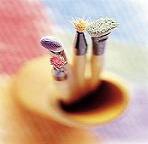

Clendening's recent art achievements include being awarded the status of "Signature Artist" member by the board of directors of the Oil Painters of America. His artwork has been juried into the last four national exhibitions, 2000-2003. Through the Art in Embassies Program of the United States Department of State, in 2002 he had two of his paintings selected to be exhibited in the public area of the U.S. Ambassadorial Residence at the Port of Spain, Trinidad & Tobago. In 2003 three more paintings were selected for the Ambassadorial Residence at Dakar, Senegal. In 1981, Clendening was elected into the Salmagundi Arts Club of New York City, which is the oldest artist run arts club in the United States. Here he has exhibited his artwork for many Years. While designing one of the space program exhibitions for the National Air & Space Museum, NASA allowed Clendening to travel with NASA artists to visit the Kennedy Space Center in Florida to sketch and observe the pre-launch work on Apollo 16 for its voyage to the Moon. "This was a busy four-day trip with many well-known artists, such as Robert McCall and Lamar Dodd," the artist said, "ending with a night visit to the launch site and the next day's launch." One of his paintings is in the art collection at the National Air & Space Museum. Other works of art are in the New Britain Museum of American Art and Columbia Museum of Art in South Carolina. Again in 1996, NASA commissioned him to produce a painting for the MIR/Shuttle rendezvous mission, which is now hanging in the Kennedy Space Center and was included in their published book, "NASA and the Exploration of Space."
During the Vietnam War, Clendening was selected by the United States Marine Corps to become its 42nd official civilian combat artist. In 1968, he went through a five-day pre-deployment training course for field grade officers at Camp Pendleton, California. "One evening after I finished that day's training, I was sitting on a hilltop sketching the surrounding landscape when a hawk swooped down a foot from my head," he recalls, "I wondered, Is this some kind of omen.?" Clendening was authorized six weeks of official leave from the National Museum of American History to go to Vietnam with the Marine Corps. "On October 23,1968, I walked onto the sandy tarmac of De Nang Air base," he recalls. "It was hot and I wondered if I was crazy for being here in Vietnam!" The Marine Corps orders gave him the equivalent rank of a Lieutenant Colonel (GS-14) which would authorize him to fly anywhere in the Marine Corps combat area, the most Northern part of South Vietnam. The combat artwork he produced is in the Marine Corps Art Collection at the Pentagon and the Navy Yard Art Museum in Washington, D.C.
Clendening worked at the Smithsonian for 36 years as an artist, designer, senior designer and finally as chief of design. "I started working at the National Museum of American History in 1960, just 22 years old," he recalls, "creating artwork and exhibit designs for the many exhibitions in American History and Art & Industry Museums. The exhibit subjects that I worked on were 'Energy Conversion' too 'the Roots of California Culture' too 'Autos and Coaches'. The objects for the exhibits would range from stamps to guns to old cars too George Washington's uniform."
In 1973 Clendening was selected to transfer to the newly planned National Air & Space Museum. "The design staff had two years, from July 1974 to July 1976, to design, coordinate, fabricate and install twenty-four exhibition galleries," he remembers. "During that time we had our design offices in the Arts & Industry Museum where I had designed the first 'World War I Aviation' exhibition and the 'Life in the Universe' exhibition. I did the conceptual design for the Space Hall and Air Transportation Hall and coordinated the fabrication and installation for these plus the Apollo to the Moon exhibition." The Air & Space Museum opened to the public on time for the nation's Bicentennial on July 4,1976. During the years after the Air & Space Museum opened, Clendening designed the 'Early Flighf exhibition, 1980; 'Stars', 1983; 'Looking at Earth', 1986; and 'Modern Aircraft Carrier Aviation', 1989 before becoming chief of design for the museum's Exhibits Department. During these years, Clendening had painted and exhibited his artwork in many art galleries around the U.S..
Clendening began his formal art studies at the Corcoran School of Art in Washington, D.C. on February 1,1958 after completing six months of active duty in the United States Army as part of the Federal Reserve Act. He decided to study art with Edmund Archer,* who was a realist painter and former assistant director at the Whitney Museum of American Art in New York. Archer had studied art at the Art Students League. In September of 1958, Clendening was awarded a monitor scholarship from Archer. "Archer taught two days a week and I was selected to be in charge the other three days," says Clendening, "taking roll, timing the figure models and keeping in class order." Clendening had won first prize for painting in his last year studying with Archer. In 1962, Clendening was awarded a scholarship at the Corcoran to study sculpture with Heinz Warneke, who produced some of the early sculpture for the National Cathedral in Washington. "Edmund Archer suggested that I study sculpture to help me better see plain forms in painting," he said. "In the sculpture class, I was taught how to carve in marble, wood and to model in clay, working from figure models." He won second prize at the Corcoran in sculpture during his first year. In 1963-64, Clendening had taught his first adult drawing and painting class at the Corcoran.